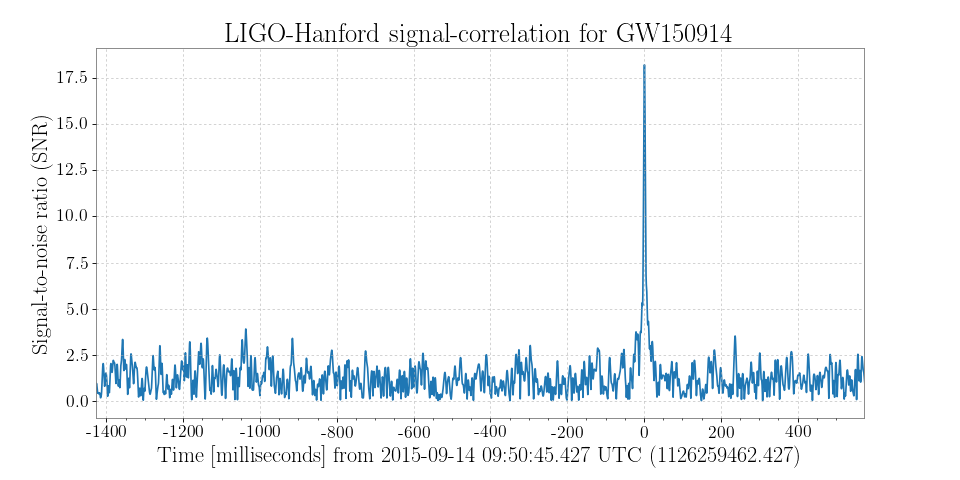7. Calculating the SNR associated with a given astrophysical signal model¶
The example Filtering a TimeSeries to detect gravitational waves showed us we can visually extract a signal from the noise using basic signal-processing techniques.
However, an actual astrophysical search algorithm detects signals by calculating the signal-to-noise ratio (SNR) of data for each in a large bank of signal models, known as templates.
Using pycbc (the actual search code), we can do that.
First, as always, we fetch some of the public data from the LIGO Open Science Center
from gwpy.timeseries import TimeSeries
data = TimeSeries.fetch_open_data('H1', 1126259446, 1126259478)
and condition it by applying a highpass at 15 Hz
high = data.highpass(15)
This is important to remove noise at lower frequencies that isn’t accurately calibrated, and swamps smaller noises at higher frequencies.
For this example, we want to calculate the SNR over a 4 second segment, so
we calculate a Power Spectral Density with a 4 second FFT length (using all
of the data), then crop() the data:
psd = high.psd(4, 2)
zoom = high.crop(1126259460, 1126259464)
In order to calculate signal-to-noise ratio, we need a signal model
against which to compare our data.
For this we import get_fd_waveform() and generate a
template FrequencySeries:
from pycbc.waveform import get_fd_waveform
hp, _ = get_fd_waveform(approximant="IMRPhenomD", mass1=40, mass2=32,
f_lower=20, f_final=2048, delta_f=psd.df.value)
At this point we are ready to calculate the SNR, so we import the
matched_filter() method, and pass it our template,
the data, and the PSD, using the to_pycbc() methods of
the TimeSeries and FrequencySeries objects:
import numpy
from pycbc.filter import matched_filter
snr = matched_filter(hp, zoom.to_pycbc(), psd=psd.to_pycbc(),
low_frequency_cutoff=15)
snrts = TimeSeries.from_pycbc(snr).abs()
We can plot the SNR TimeSeries around the region of interest:
plot = snrts.plot()
ax = plot.gca()
ax.set_xlim(1126259461, 1126259463)
ax.set_epoch(1126259462.427)
ax.set_ylabel('Signal-to-noise ratio (SNR)')
ax.set_title('LIGO-Hanford signal-correlation for GW150914')
plot.show()
(png)

We can clearly see a large spike (above 17!) at the time of the GW150914 signal! This is, in principle, how the full, blind, CBC search is performed, using all of the available data, and a bank of tens of thousand of signal models.